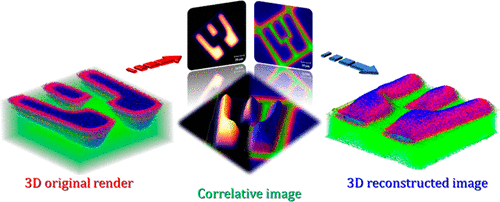当前位置:
X-MOL 学术
›
Anal. Chem.
›
论文详情
Our official English website, www.x-mol.net, welcomes your
feedback! (Note: you will need to create a separate account there.)
Improvement of the Correlative AFM and ToF-SIMS Approach Using an Empirical Sputter Model for 3D Chemical Characterization
Analytical Chemistry ( IF 6.7 ) Pub Date : 2018-01-10 00:00:00 , DOI: 10.1021/acs.analchem.7b03431 T. Terlier 1 , J. Lee 1 , K. Lee 1 , Y. Lee 1
Analytical Chemistry ( IF 6.7 ) Pub Date : 2018-01-10 00:00:00 , DOI: 10.1021/acs.analchem.7b03431 T. Terlier 1 , J. Lee 1 , K. Lee 1 , Y. Lee 1
Affiliation

|
Technological progress has spurred the development of increasingly sophisticated analytical devices. The full characterization of structures in terms of sample volume and composition is now highly complex. Here, a highly improved solution for 3D characterization of samples, based on an advanced method for 3D data correction, is proposed. Traditionally, secondary ion mass spectrometry (SIMS) provides the chemical distribution of sample surfaces. Combining successive sputtering with 2D surface projections enables a 3D volume rendering to be generated. However, surface topography can distort the volume rendering by necessitating the projection of a nonflat surface onto a planar image. Moreover, the sputtering is highly dependent on the probed material. Local variation of composition affects the sputter yield and the beam-induced roughness, which in turn alters the 3D render. To circumvent these drawbacks, the correlation of atomic force microscopy (AFM) with SIMS has been proposed in previous studies as a solution for the 3D chemical characterization. To extend the applicability of this approach, we have developed a methodology using AFM–time-of-flight (ToF)-SIMS combined with an empirical sputter model, “dynamic-model-based volume correction”, to universally correct 3D structures. First, the simulation of 3D structures highlighted the great advantages of this new approach compared with classical methods. Then, we explored the applicability of this new correction to two types of samples, a patterned metallic multilayer and a diblock copolymer film presenting surface asperities. In both cases, the dynamic-model-based volume correction produced an accurate 3D reconstruction of the sample volume and composition. The combination of AFM–SIMS with the dynamic-model-based volume correction improves the understanding of the surface characteristics. Beyond the useful 3D chemical information provided by dynamic-model-based volume correction, the approach permits us to enhance the correlation of chemical information from spectroscopic techniques with the physical properties obtained by AFM.
中文翻译:

使用经验溅射模型对3D化学特征进行相关AFM和ToF-SIMS方法的改进
技术进步推动了日益复杂的分析设备的发展。现在,根据样品量和成分对结构进行全面表征非常复杂。在此,基于用于3D数据校正的高级方法,提出了一种用于样品3D表征的高度改进的解决方案。传统上,二次离子质谱(SIMS)提供样品表面的化学分布。将连续溅射与2D表面投影相结合,可以生成3D体积渲染。但是,表面形貌可以通过将非平坦表面投影到平面图像上来扭曲体积渲染。此外,溅射高度依赖于所探测的材料。成分的局部变化会影响溅射产量和光束引起的粗糙度,反过来会改变3D渲染。为了克服这些缺点,在先前的研究中已经提出了原子力显微镜(AFM)与SIMS的相关性作为3D化学表征的解决方案。为了扩展此方法的适用性,我们开发了一种方法,该方法使用AFM飞行时间(ToF)-SIMS结合经验性溅射模型“基于动态模型的体积校正”来普遍校正3D结构。首先,与传统方法相比,对3D结构的仿真突出了此新方法的巨大优势。然后,我们探索了这种新校正方法对两种类型样品的适用性,一种是带图案的金属多层膜,另一种是具有表面凹凸的双嵌段共聚物膜。在这两种情况下 基于动态模型的体积校正可对样品的体积和成分进行精确的3D重建。AFM–SIMS与基于动态模型的体积校正相结合可提高对表面特性的理解。除了基于动态模型的体积校正提供的有用的3D化学信息外,该方法还使我们能够增强光谱技术的化学信息与AFM获得的物理特性之间的相关性。
更新日期:2018-01-10
中文翻译:

使用经验溅射模型对3D化学特征进行相关AFM和ToF-SIMS方法的改进
技术进步推动了日益复杂的分析设备的发展。现在,根据样品量和成分对结构进行全面表征非常复杂。在此,基于用于3D数据校正的高级方法,提出了一种用于样品3D表征的高度改进的解决方案。传统上,二次离子质谱(SIMS)提供样品表面的化学分布。将连续溅射与2D表面投影相结合,可以生成3D体积渲染。但是,表面形貌可以通过将非平坦表面投影到平面图像上来扭曲体积渲染。此外,溅射高度依赖于所探测的材料。成分的局部变化会影响溅射产量和光束引起的粗糙度,反过来会改变3D渲染。为了克服这些缺点,在先前的研究中已经提出了原子力显微镜(AFM)与SIMS的相关性作为3D化学表征的解决方案。为了扩展此方法的适用性,我们开发了一种方法,该方法使用AFM飞行时间(ToF)-SIMS结合经验性溅射模型“基于动态模型的体积校正”来普遍校正3D结构。首先,与传统方法相比,对3D结构的仿真突出了此新方法的巨大优势。然后,我们探索了这种新校正方法对两种类型样品的适用性,一种是带图案的金属多层膜,另一种是具有表面凹凸的双嵌段共聚物膜。在这两种情况下 基于动态模型的体积校正可对样品的体积和成分进行精确的3D重建。AFM–SIMS与基于动态模型的体积校正相结合可提高对表面特性的理解。除了基于动态模型的体积校正提供的有用的3D化学信息外,该方法还使我们能够增强光谱技术的化学信息与AFM获得的物理特性之间的相关性。











































 京公网安备 11010802027423号
京公网安备 11010802027423号